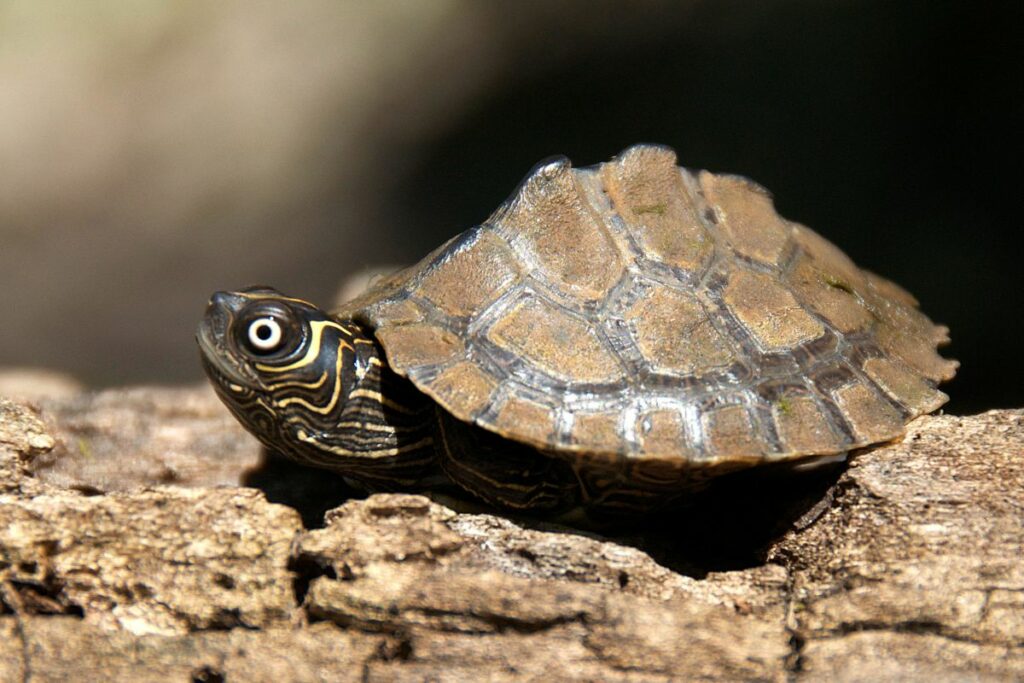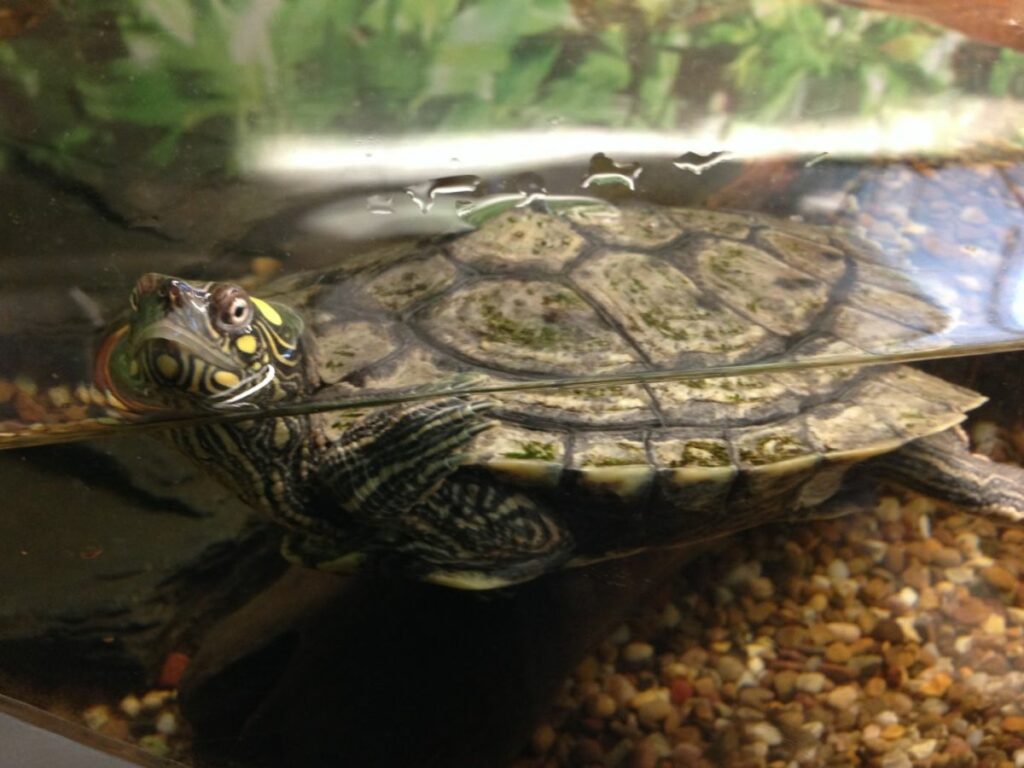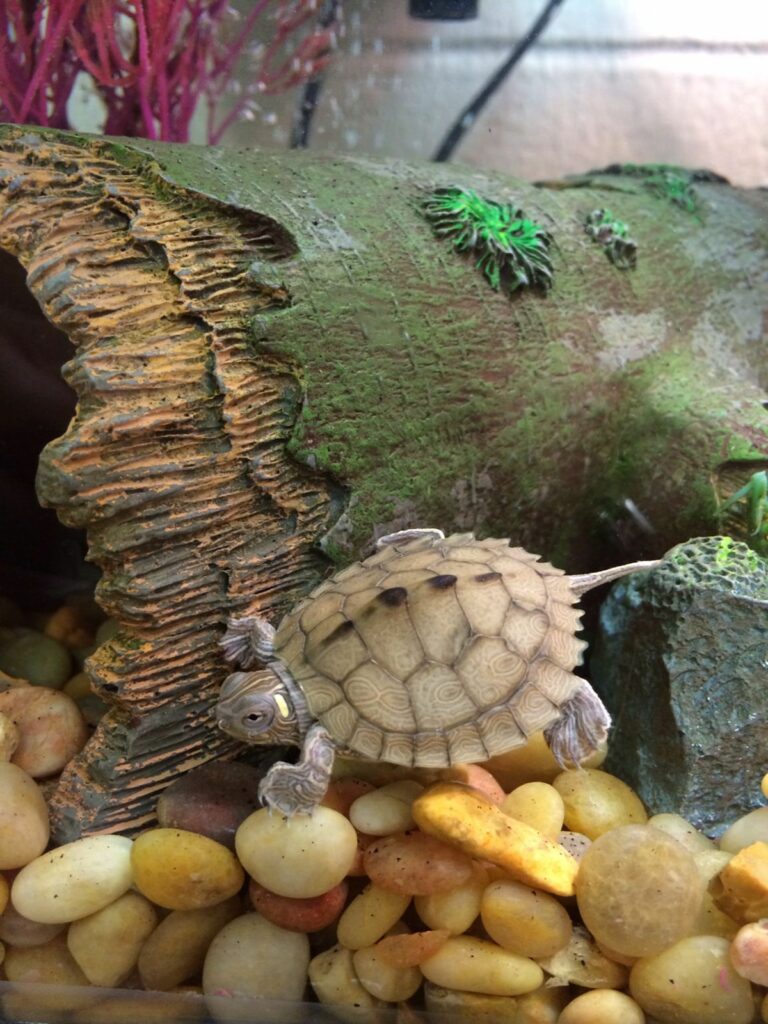Mississippi Map Turtles are an active species of aquatic turtle that’s one of the most popular varieties for beginners. Also known as Sawback Turtles, they are easy to care for and undemanding pets.

While Map Turtles don’t enjoy being held they aren’t as aggressive as other turtles. And their unique appearance makes them a favorite of even expert turtle keepers.
What is the Mississippi Map Turtle?
As the name suggests you will find Mississippi Map Turtles in not just the state of Mississippi but everywhere the river touches. The Mississippi watershed is huge and you will find this aquatic turtle as far north as Illinois.
Map Turtles are a favorite of first time turtle keepers who want something different from the usual Painted Turtle or Red Eared Slider. Theys have intriguing squiggles along their faces, highlighted by their pale shell color. Turtles Mississippi also have jagged ridges along their backs that few other species possess.
Map Turtles are a little more sensitive when it comes to habitat requirements but are not a difficult species to care for. The main thing is to make sure you buy the right technology for their habitat (lights and filtration).
Mississippi and Common Map Turtles also are not a handleable species. They are quite shy and will flee if you try. A Map Turtle may even try biting you if you pester them too often with touching. But their unique appearance more than makes up for their lack of personality.
Map Turtle Lifespan
Aquatic turtles are long-lived animals. The Mississippi Map Turtle lifespan is around 20 years, +/- 5 years. A few exceptional specimens will live as long as 30 years or more if well cared for.
- Common Names: Mississippi Map Turtle, Sawback Map Turtle
- Scientific Name: Graptemys pseudogeographica kohni
- Origin: Central United States
- Length: 5 inches for males; 10 inches for females
- Tank Size: 75-125 gallons
- Lifespan: 20+ years
- Ease of Care: Easy
What About the Common Map Turtle?
Sometimes you will also see a close relative sold with the same name: the Common Map Turtle (Graptemys geographica). The two species look superficially similar.
But despite their name the Common Map Turtle is not as easy to find in pet stores or from breeders. Its stripes aren’t as bold and it does not have the prehistoric looking shell ridges that make the Mississippi Map Turtle so popular.
That aside, Common Map Turtle diet, size, and care needs are all the same as the Mississippi Map Turtle. Even though Common Map Turtles aren’t as attractive-looking as the Mississippi variety they tend to be a little pricier. Demand is low so Common Map turtles appeal mostly to reptile specialists who want unique additions for their collection.
Mississippi Map Turtle Care
Mississippi Map Turtle care is similar to that of other aquatic turtles. A varied diet, UV and infrared lighting, and well-filtered water are the keys to success.

How Big Does a Map Turtle Get?
The size of a full grown Mississippi Map Turtle is hard to know for sure because they are very seuxally dimorphic. The adult size of most aquatic turtles depends on the sex of the animal.
But the size difference is extreme in this species. Female map turtle size is anywhere from 6 to 10 inches long while males will grow no larger than 5 inches.
Mississippi Map Turtle Tank Setup
The size difference is so dramatic that the final aquarium size depends on the sex of your turtle. If your Mississippi Water Turtle is a female then you will need a tank up to 125 gallons in size. Yet the much smaller male will live with comfort in a 55-75 gallon aquarium.
An aquarium that is both wide and deep is important because map turtles spend a lot of time swimming. You’ll need at least 10 inches of depth, with even deeper water better for a large female Map Turtle.
Filtration for Mississippi Water Turtles
One reason why beginning turtle keepers don’t succeed with this species is because Map Turtles are sensitive to poor water conditions. High levels of ammonia and other pollutants will cause them to develop skin issues and toxicity.
Providing clean water is a challenge for any turtle tank because aquatic turtles enjoy eating and pooping in their water. In the wild, waste would just be swept downstream. But in an aquarium, it collects and decays into toxic pollutants.
A good water filter is necessary when keeping aquatic turtles. If your filter is submersible make sure it has a guard so the turtle can’t damage it when diving.
The water should also be heated to 75-85°F – and don’t forget a guard for your turtle tank heater. A guard is even more important for the heater than the filter. A cracked heater may electrocute you or your turtle if damaged.
Basking Lights for Mississippi Map Turtles
Another important part of Mississippi Map Turtle care is to provide the right lighting. There’s more to it than just buying a fluorescent light fixture, however.
All reptiles need full-spectrum tank lighting. That’s not only visible light but also ultraviolet (UVb) and infrared (heat) radiation. That said, most pet stores carry both UVb and infrared bulbs for turtle tanks.
The basking area should have an air temperature of 78-90°F. Use a thermometer to also check how hot the ground is underneath the heat bulbs. The air temperature is often cooler than the surface of the basking zone. Anything above 96°F is too hot and may burn a Map Turtle belly.

What Do Map Turtles Eat?
Like most aquatic turtles the Mississippi Map Turtle is an omnivore. They feed on aquatic insects, floating vegetation, dead animals, and anything else slow enough to catch.
Your Mississippi Map Turtle diet should be rich in variety as well. Most pet stores carry earthworms, mealworms, beetles, crickets, and hissing roaches as food for reptiles. Supplement these with fresh pieces of seafood and a high-quality turtle pellet.
Mississippi Map Turtle food should also consist of vegetables. Romaine lettuce, spinach, chard, parsley, and other leafy greens are their favorites. And you should add skinned pieces of soft fruit and vegetables like apple, grapes, melon, and squash.
Both vegetables and meat should be dusted with a blend of calcium and vitamin powder. In this way your Map Turtle’s shell remains strong.
Can I Hold Sawback Turtles?
If you are looking for an aquatic turtle pet to handle, Map Turtles are not the right choice. These are some of the more skittish turtle varieties. Even when kept in captivity for years a Map Turtle may still bolt for the water if you get too close to the tank.
You may still handle them as needed for shell cleaning or aquarium maintenance. But Map Turtles are shy so consider them a viewing-only type of turtle.
If frightened enough they may even try to bite. Their bite isn’t super painful. But a bite might surprise an unwary person enough to drop the turtle, which is very dangerous as their shell could crack. Sawback Turtles, therefore, are not the best choice for young children, who will be tempted to pick up their turtle pets.
Conclusion
So long as you are providing proper lighting, good filtration, and a varied diet, your Mississippi Map Turtles will thrive. The size difference between the sexes means you might need a larger aquarium than expected. And they don’t appreciate being handled often. But overall, Map Turtles are trouble-free and long-lived aquatic pets.
More Frequently Asked Questions about Mississippi Map Turtles
Mississippi Map Turtles are excellent beginner’s turtles. But sometimes people are hesitant to try them since they are not as common as sliders and painted turtles. So here are a few frequently asked questions about Map Turtle care.
Mississippi Map Turtle full size depends on the sex of the animals. Male turtles will reach up to 5 inches while females will be as long as 10 inches. Even for aquatic turtles they show remarkable size differences between the two sexes.
Mapping Turtles are not as long lived as other pet turtles. But 20 to 30 years is still a long lifespan. So make sure you’re committed before choosing Map Turtles as pets.
Mississippi and Common Map Turtles are both omnivorous. That means they eat both plants and animals, same as us humans. Aquatic turtles do tend to eat more meat than vegetables, however. Aquatic insects and other invertebrates are their favorites. Along with the occasional fish or dead mammal. But leafy greens and soft fruits or vegetables should also be a part of their diet.

